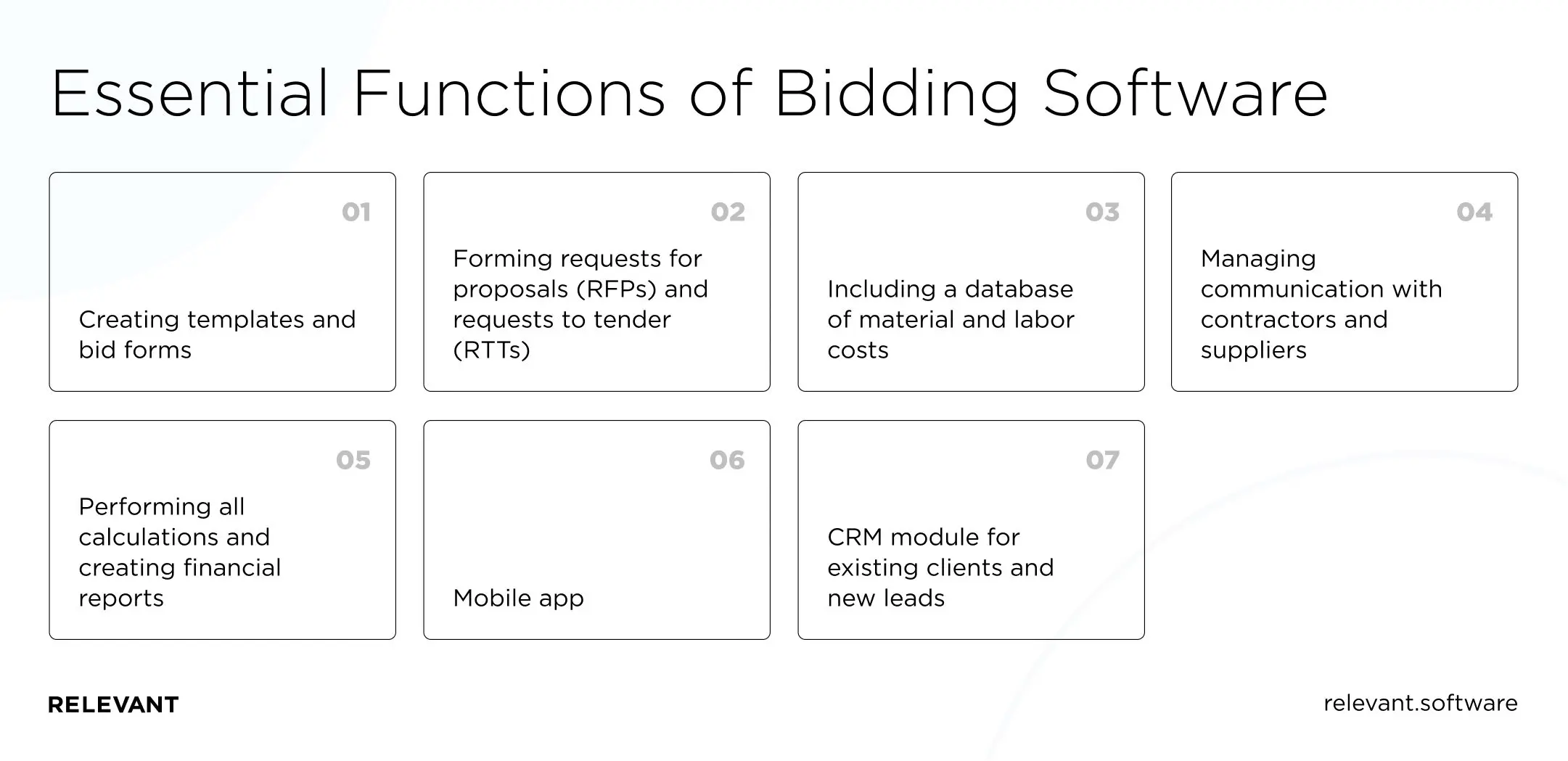How to Build an Auction Website or System: Relevant Software's Guide

In the epoch of digitalization, opportunities abound, and the online auction marketplace is a prime example. Platforms like eBay, Etsy, and Copart cater to a broad audience seeking consumer goods, services, and luxury items. Recognizing the shift in consumer behavior toward digital solutions, even renowned art auction houses like Sotheby’s and Christie’s have transitioned their operations online. The driving factors behind this change are convenience, a wider audience, and the constant availability of services. As a result, these shifts are forecasted to propel the industry to $2.50 billion by 2027.
But online auctions aren’t just for consumer goods. They’re also transforming the construction industry, where contractors submit intricate tenders at short notice. Efficient online systems then manage, analyze, and select the most competitive offers.
So, how to build an auction website? We will shed light on the development process from our first-hand experience in the construction industry.
Why There’s a Necessity for Custom Bidding System Development
As businesses strive to differentiate themselves, the need for tailored solutions becomes more pronounced, and the realm of online auctions is no exception. Therefore, the demand for custom bidding system development is on the rise.
But what underpins this growing need? To unravel this, let’s first investigate why auctions, especially online ones, have become crowd-pleasers.
The Reasons People Like Auctions
Auctions are more than a platform for transactions; they offer a captivating experience characterized by suspense, competition, and the thrill of a potential bargain. This dynamic environment keeps participants on their toes, providing an adrenaline-fueled, game-like experience distinctly different from regular shopping.
In the digital world, these elements are magnified. Online auctions offer unparalleled convenience and a global marketplace, thereby expanding the scope of opportunities for both buyers and sellers. Participants can bid from the comfort of their homes anytime and potentially land lucrative deals on various goods and services, making online auctions a formidable force in the e-commerce landscape.

Bidding Software for Construction Businesses
If you look at the construction businesses, the story becomes even more compelling. Construction bidding is a highly complex process involving numerous contractors submitting detailed proposals under tight deadlines. The intricate nature of this process necessitates a sophisticated system to manage, analyze, and select the best bids.
Custom bidding software, tailored to the unique needs of construction businesses, can streamline this process and offer many advantages. It can enhance efficiency, foster transparency, and enable robust comparisons of bids, thereby ensuring the selection of the most cost-effective and competent proposals.
Additionally, unlike off-the-shelf solutions, a custom-built bidding platform provides flexibility, scalability, and the ability to incorporate industry-specific features. For instance, it can be designed to handle different types of bids, facilitate secure document exchange, and enable real-time communication among stakeholders.
In conclusion, the need for custom bidding system development is not a trend; it is a market necessity driven by the unique requirements of businesses and the appeal of auctions. As construction businesses seek to leverage technology to optimize their operations, custom bidding software emerges as an invaluable tool that can deliver significant competitive advantages.
Essential Features of Bidding Software
To stand out in this competitive market, your software needs to offer a robust set of features that cater to the needs of your users, ensuring an efficient, secure, and intuitive bidding experience. Below are the essential features any top-tier bidding software must possess:
Streamlined Templates and Bid Forms
A key objective of bid management solutions is to simplify the complex bid compilation and submission process. In this respect, customizable templates and bid forms are invaluable aids, contributing to the ease of use, speed, and accuracy in bid preparation.
Tools for Requests for Proposals and Requests to Tender
Collaborating with suppliers and contractors necessitates the exchange of project-related information and estimates. Thus, having the ability to create and disseminate formal inquiries like RFPs and RTTs easily is paramount, enhancing the efficiency and professionalism of the interaction.
Comprehensive Database of Material and Labor Costs
The fast-paced nature of construction bidding often demands quick bid creation. A dynamic, up-to-date database of material and labor costs is a must-have feature, enabling swift and accurate bid preparation.
Efficient Communication Management
Real-time communication with contractors and suppliers becomes crucial with changing requirements and evolving circumstances. A bid management solution should facilitate seamless notifications and updates, ensuring all stakeholders remain informed and aligned.
Automated Calculations and Financial Reporting
Bid management involves significant financial calculations, where human error can be costly. Incorporating automated calculation capabilities not only speeds up workflows but also minimizes potential inaccuracies. Furthermore, creating comprehensive financial reports becomes more manageable, lending transparency and accountability to the process.

Yet, an online auction website must go beyond the basics to truly make a mark in the increasingly competitive digital landscape. Therefore, here are some compelling, innovative features to consider when starting an auction business:
Mobile Application
In today’s mobile-centric world, providing quick and convenient access to bidding software functionalities is not just desirable; it’s a necessity. A mobile application facilitates real-time tracking, updates, and interaction, empowering users to stay connected on the go.
CRM Module for Client Management
Maintaining effective communication with existing clients and efficiently managing new leads is pivotal for business growth. Integrating a CRM module into your bidding software grants better relationship management, improving client satisfaction and potentially driving more business your way.

10 Steps of Custom Bidding System Development
Understanding how to set up an auction website is essential to creating a dynamic, user-friendly platform that facilitates seamless online bidding and selling.
So, how to create an online auction site or a custom bidding system? It is a complex process requiring strategic planning, technical prowess, and robust execution. To navigate this journey effectively, here is a definitive nine-step blueprint to follow:
Define Your Goal
The first step in any custom web development journey begins with setting clear and measurable goals. What problems does your bidding system aim to solve? Who is your target audience? What unique value proposition do you intend to offer? Answering these questions sets a concrete foundation and paves the way for informed decisions down the line.
Choose an Auction Model
The next step is selecting the appropriate auction model, which will significantly influence your platform’s functionality and user experience. Six key live auction models include:
- English Auction: Bidding starts at the opening bid or reserve price, and the merchandise goes to the top bidder.
- Penny Auction: Bidding starts low, with fixed increments until no further bids are received.
- Dutch Auction: Bidding opens high and decreases until a bid surpasses the reserve price.
- Sealed Bid Auction: Bidders submit a single, undisclosed bid. The highest bid wins.
- Vickrey Auction: The highest bid wins but pays the second-highest bid amount.
- Double Auction: Numerous buyers and sellers participate by submitting their bids and offers. A clearing price is set, allowing trades above (for buyers) or below (for sellers) this price.
Select Your Monetization Approach
Monetization is crucial when launching an online auction platform or bidding software. The chosen monetization strategy can directly impact the platform’s success, longevity, and user adoption rate. The following are the primary approaches to monetizing online auctions and bidding software:
- Subscription: A clear-cut and straightforward approach involving a recurring fee, charged monthly or annually.
- Premium Functionality: Often referred to as the freemium model, this strategy charges users for access to additional features not included in the base version.
- Seller Fees: Fees charged to sellers can vary, including a fixed percentage on successful sales or a charge for exceeding a listing limit in various categories.
- Payment Partnerships: By aligning with a payment system, commissions can be accrued from transactions and financing plans.
- Advertising: A favored option for generating revenue from traffic on bidding websites.
Outline Features and Design
Now, it’s time to outline the crucial features your platform should have, based on the discussions above. Don’t forget to include the fundamental features of bidding software and the innovative functionalities that can set your platform apart.
- Listing: Allows sellers to add, modify, or delete items with comprehensive details.
- Data Storage: Secure storage for sensitive information is crucial.
- Newsletter: Regularly inform customers about new listings via email.
- Bidding Function: Support for various auction types and strategies.
- Auction Details: Information about auction times, items, winners, bidders, etc.
- Payment Gateways: Incorporate popular payment methods like Paypal and Stripe.
- Messaging: Foster effective and direct interaction between sellers and buyers.
- Analytics: Empower with valuable insights into product views, purchases, conversion rates, and more, enabling data-driven decision-making.
- User Profile: Allow to create personalized profiles with user-friendly registration and login forms.
- Search Tool: Include a search bar for easy product finding.
- Bid Templates: Help sellers easily list multiple different products.
- Shopping Cart: Allows customers to purchase multiple products in one transaction, etc.
In parallel, a compelling design that ensures user-friendly navigation should be conceptualized. Here are some tips for effective UI/UX design:
- Maintain simple navigation, avoiding complex dropdown menus.
- Use high-quality images to enhance user experience.
- Ensure secure payment options and an accessible refund policy for trust-building.
- Use a vibrant color palette and highlight action buttons for ease of use.
- Include a “Deal of the Day” section to engage users.
Select Development Methods and the Right Tech Stack
The selection of development methodologies and technological stack is a critical determinant of the efficiency of your software solution. Whether you opt for agile, waterfall, or hybrid development methods, ensure they align with your project requirements. Your tech stack should consider the chosen auction model, desired features, scalability requirements, and security considerations. Typically, you’ll deal with:
- Front-end technologies like HTML, CSS, JavaScript, React, or Vue.js for the user interface.
- Back-end technologies like Node.js or Ruby on Rails for server logic.
- Database tools like MySQL or MongoDB for data storage.
- Payment gateways like Stripe, Braintree, or PayPal for transactions.
- Messaging APIs such as Twilio, SendGrid, or Mailchimp for notifications.
- Analytics tools like Google Analytics for user behavior metrics.
- Cloud services such as Azure or AWS for hosting and scaling.
Assemble Your Team
Now, you have to decide whether to rely on your internal resources or hire remote software developers. This decision should consider factors such as time constraints, budget, and potential gaps in expertise.
Design and Develop an MVP
Before building a full-fledged product, creating a Minimum Viable Product (MVP) is advisable. An MVP is the initial, bare-bones version of your bidding software. It includes only essential features and functions, allowing for user feedback and product validation before committing additional resources. Without this step, you risk encountering substantial issues during later development stages, potentially leading to costly redirection and rework.
Finalize the Product, Test, and Launch
After refining your product based on MVP feedback, it’s time to finalize your platform, adding the remaining features and fine-tuning the design. Rigorous testing must follow to ensure there are no bugs, security vulnerabilities, or usability issues. After thorough quality assurance, you are ready to launch your custom bidding system to the world.
Ensure the security
When contemplating how to create your own auction website, ensuring a high level of security for all transactions is crucial. You can achieve this by integrating secure payment gateways, SSL certificates, and advanced encryption methods for sensitive data. Also, regular audits and security checks are advisable to ensure system integrity.
Don’t Forget About Continuous Improvement and Support
However, your journey doesn’t end at launch. Continual improvement and dedicated support are critical for your platform’s longevity and user satisfaction. Monitor user behavior, gather feedback, and stay abreast of industry trends to keep improving your platform and stay competitive in the ever-evolving digital landscape.
How We Developed Bidding Software
At Relevant, our collective experience stems from successfully executing over 200 projects for clientele from 25 countries over ten years. We’ve embraced challenges, devised innovative solutions, and consistently exceeded expectations, earning a five-star Clutch rating. One such project was the development of Biderator, a custom bidding software.
Biderator idea
When our client approached us with the idea of a Biderator, we immediately recognized the project’s unique demands and potential. The goal was to develop an online bidding platform that seamlessly connected contractors with projects, eliminating the common issues of ambiguous estimates and unclear deadlines. Eagerly, we rolled up our sleeves and embarked on this exciting journey.
Biderator’s features
Biderator’s dynamic, location-based listings gave users short page load times and robust control of multiple flows. Sorting contractors by region became a breeze.
The platform enables managers to swiftly post, modify, and supplement jobs with extensive documentation for prospective contractors. Bidders seeking additional information could access it conveniently through the RFI (Request for Information) section.
At the core of the service was the sophisticated bidding engine. This feature empowered contenders to post and adjust their bids based on evolving project requirements and track other bids in real time.
Development Approach and Tech Implementation
The success of Biderator is credited to our meticulous selection of technologies, strategic approach to development, and effective project management.
We leveraged the RACI (Responsible, Accountable, Consulted, Informed) matrix to define roles and responsibilities clearly, ensuring seamless collaboration despite time zone differences. By opting for user testing, we managed to adhere to the client’s budget without compromising the project’s quality. We recorded all team meetings to keep stakeholders informed, allowing them to view discussions at their convenience.
Server-side HTML rendering ensured that Biderator’s pages loaded with lightning speed. We utilized Reactive Extensions for JavaScript (RxJS) to handle multiple asynchronous data streams simultaneously. This technology also allowed us to optimize the application’s performance across different devices.
The successful realization of Biderator is a testament to our commitment to delivering high-quality, custom-built solutions that cater to our clients’ specific needs. It underscores our technical expertise and highlights our flexible and adaptive project management approach, which is crucial for dealing with complex projects with evolving requirements.
The Costs of Bidding System Development
Determining how much it costs to build an auction website involves several factors, including the complexity of the design, the functionality required, the platform’s scalability, and the level of customization, making it essential to consider these elements when budgeting for such a project. However, a pivotal decision awaits – whether to build your team in-house or outsource the development process.
If you’re considering the in-house route for developing your auction website, you’ll need to budget for salaries, which typically range from $80 to $150 per hour per team member. Additionally, you’ll need to account for office space, equipment, benefits, and bonuses.
On the other hand, outsourcing opens the door to a larger talent pool and offers competitive hourly rates and no infrastructure costs required for development. It also frees you of the responsibility of team scaling; the software partner manages team assignments based on your needs. The offshore software development team is an excellent choice if you want to retain your focus on your core business functions while the development process proceeds simultaneously.
Keep in mind that the duration of your software development project will depend greatly on its size and complexity. To obtain a more accurate estimate when creating an auction website, it is recommended to engage in consultation with your selected software partner.
The Bottom Line
Online bidding systems, particularly within the construction industry, are here to stay and set to continue growing in popularity. Given the intricacies of submitting tenders and selecting the best bid, any bidding software must be meticulously designed for efficiency and reliability. That necessitates choosing a vendor with a robust technical background and ample experience.
If you’re ready to build your own online auction website but need clarification on the starting point, Relevant is here to help. We’re equipped to build your custom product from scratch or augment your existing teams with our skilled dedicated developers as and when needed for as long as required.
Let’s connect and fast-track your way to the development of a comprehensive and efficient bidding system.



